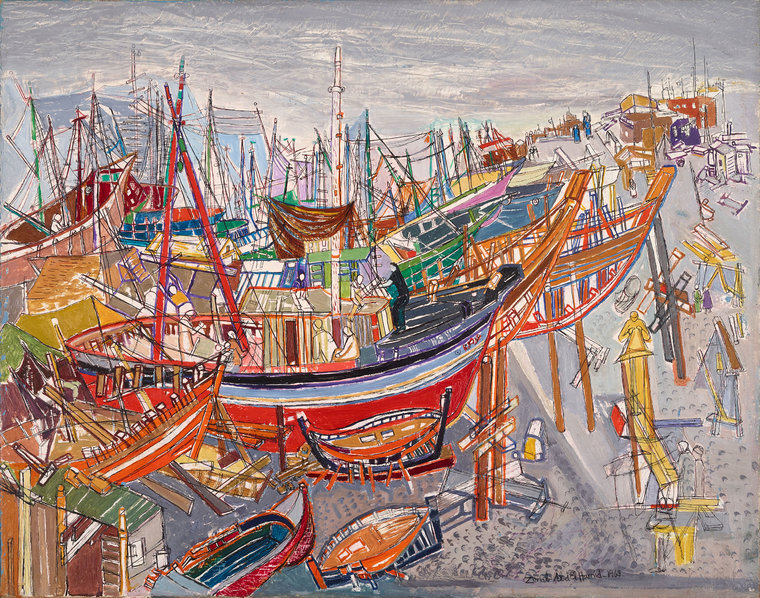Zeinab Abdel Hamid's Chantier Occupé, 1963, depicts a bustling shipbuilding yard at a port, where boats appear to pile on top of each other in a frenzy of ship scaffolding, poles, rope, sheds, and workshops. The elements are outlined in black in an illustrative, sketch-like manner, with the energetic and angular brushstrokes creating a bustling sense of dynamism.
Abdel Hamid stands out among landscape and cityscape painters in Egypt for her unique use of alternating perspectives. This work is exemplary of her approach as she intentionally tries to confuse the viewer's sense of perspective, creating a sense of uncertainty regarding the distance and point of view through which these objects are presented. Furthermore, she uniquely incorporates geometric shapes reminiscent of Islamic art usually found in everyday items like carpets and ceramics. They are characterized by brightly colored patterns outlined in thick black lines. Not bound by the rules of Islamic geometry, she innovates by allowing these forms to interact with the chaotic movement of the modern world. While she draws from the patterned and well-structured representation of Islamic art, her compositions include multiple elements that are irregularly distributed across a painting’s surface in many directions. In the process, Abdel Hamid transforms traditional forms into dynamic representations of contemporary life.
A pioneering woman artist of the mid-century, Abdel Hamid was born in 1919 and grew up during the emergence of an independent post-colonial Egypt in 1922. As a co-founder of the Modern Art Group in 1946, alongside artists Gazbia Sirry and Abdel Hadi El-Gazzar, she played a significant role in shaping the country's modern art scene. Her paintings often show the bustling busy life of the popular working sector of the city. Chantier Occupé is a 1960s work that reflects the era's sociopolitical transformation, marked by rapid modernization and nation-building under Gamal Abdel Nasser's leadership, following the 1952 revolution that toppled the monarchy. The painting reflects the Nasserist ideology, which celebrated the working class as the nation's backbone during a time of modernization and industrialization, capturing the spirit of the era and the daily lives of working people. Through her unique form of dynamic social realism, she conveys a celebratory sense of movement and labor, breathing life into the landscape in her depiction of modern Egypt.
Abdel Hamid’s portrayal of traditionally male-dominated spaces, such as shipyards and men’s cafes, breaks boundaries by incorporating women's artistic voices in documenting all aspects of Egyptian life, including labor, community and industry, defying the stereotype that women should focus on "softer" themes like domestic life. Abdel Hamid was nominated for the 1956 Guggenheim International Award and represented Egypt at the 1958 Venice Biennale. She received international recognition for her depictions of Cairo's urban landscapes and a vision of Egypt at the forefront of modernity.
Signed in English front lower left with date 1963.




